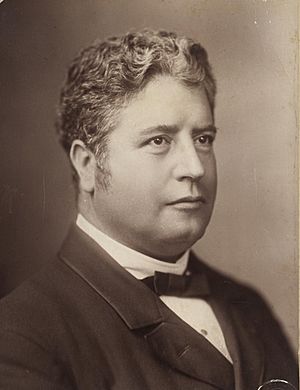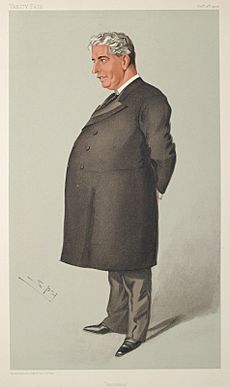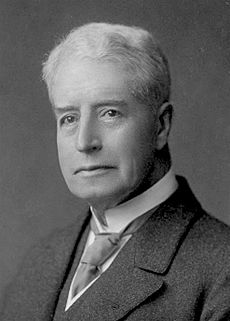Edmund Barton facts for kids
Quick facts for kids
Edmund Barton
|
|||||||||||||||||||||||||||||||||||||||||||||||||||||||||||
|---|---|---|---|---|---|---|---|---|---|---|---|---|---|---|---|---|---|---|---|---|---|---|---|---|---|---|---|---|---|---|---|---|---|---|---|---|---|---|---|---|---|---|---|---|---|---|---|---|---|---|---|---|---|---|---|---|---|---|---|
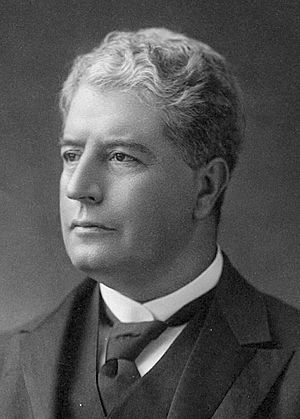
Barton in 1902
|
|||||||||||||||||||||||||||||||||||||||||||||||||||||||||||
| 1st Prime Minister of Australia | |||||||||||||||||||||||||||||||||||||||||||||||||||||||||||
| In office 1 January 1901 – 24 September 1903 |
|||||||||||||||||||||||||||||||||||||||||||||||||||||||||||
| Monarch | Victoria Edward VII |
||||||||||||||||||||||||||||||||||||||||||||||||||||||||||
| Governor-General | Lord Hopetoun Lord Tennyson |
||||||||||||||||||||||||||||||||||||||||||||||||||||||||||
| Preceded by | Office established | ||||||||||||||||||||||||||||||||||||||||||||||||||||||||||
| Succeeded by | Alfred Deakin | ||||||||||||||||||||||||||||||||||||||||||||||||||||||||||
| Justice of the High Court of Australia | |||||||||||||||||||||||||||||||||||||||||||||||||||||||||||
| In office 5 October 1903 – 7 January 1920 |
|||||||||||||||||||||||||||||||||||||||||||||||||||||||||||
| Nominated by | Alfred Deakin | ||||||||||||||||||||||||||||||||||||||||||||||||||||||||||
| Appointed by | Lord Tennyson | ||||||||||||||||||||||||||||||||||||||||||||||||||||||||||
| Preceded by | Office established | ||||||||||||||||||||||||||||||||||||||||||||||||||||||||||
| Succeeded by | Hayden Starke | ||||||||||||||||||||||||||||||||||||||||||||||||||||||||||
|
|||||||||||||||||||||||||||||||||||||||||||||||||||||||||||
|
|||||||||||||||||||||||||||||||||||||||||||||||||||||||||||
| Personal details | |||||||||||||||||||||||||||||||||||||||||||||||||||||||||||
| Born | 18 January 1849 (now New South Wales, Australia) |
||||||||||||||||||||||||||||||||||||||||||||||||||||||||||
| Died | 7 January 1920 (aged 70) Hydro Majestic Hotel, Medlow Bath, New South Wales, Australia |
||||||||||||||||||||||||||||||||||||||||||||||||||||||||||
| Resting place | Waverley Cemetery | ||||||||||||||||||||||||||||||||||||||||||||||||||||||||||
| Political party | Protectionist (after 1887) | ||||||||||||||||||||||||||||||||||||||||||||||||||||||||||
| Spouse |
Jane Ross
(m. 1877) |
||||||||||||||||||||||||||||||||||||||||||||||||||||||||||
| Children | 6 | ||||||||||||||||||||||||||||||||||||||||||||||||||||||||||
| Education |
|
||||||||||||||||||||||||||||||||||||||||||||||||||||||||||
| Alma mater | University of Sydney | ||||||||||||||||||||||||||||||||||||||||||||||||||||||||||
| Profession | Barrister Politician |
||||||||||||||||||||||||||||||||||||||||||||||||||||||||||
| Signature | |||||||||||||||||||||||||||||||||||||||||||||||||||||||||||
Sir Edmund "Toby" Barton (born 18 January 1849, died 7 January 1920) was a very important Australian politician and judge. He became Australia's very first Prime Minister in 1901, serving until 1903. After that, he helped start the High Court of Australia and worked as a judge there until he passed away.
Barton was a strong supporter of federation, which was the idea of joining all the separate Australian colonies into one country. He famously said his goal was "a nation for a continent, and a continent for a nation." He played a huge part in writing Australia's national constitution. He also led the campaigns to convince people to vote for federation.
When Australia became a nation on 1 January 1901, Barton was chosen to be the first Prime Minister. His government created many new national groups, like the Australian Defence Force. They also gave women the right to vote across the country. Barton left politics in 1903 to become one of the first three judges on the High Court. This court helps explain the constitution he worked so hard to create.
Contents
Early Life of Edmund Barton
Edmund Barton was born in Glebe, Sydney, on 18 January 1849. He was one of twelve children. His parents, Mary Louisa and William Barton, came from London, England. William Barton worked in different jobs, like an accountant and a real estate agent. Sometimes he had money troubles. To help out, Edmund's mother ran a school for girls.
Growing Up and Going to School
Barton spent his early years in Glebe before his family moved to The Rocks in Sydney. His parents were very good at reading and writing. His mother especially encouraged his studies. Barton first went to Fort Street Public School. Later, he attended Sydney Grammar School, which had just opened.
One of his good friends from childhood was Richard Edward O'Connor. Richard would later become a judge with Barton on the High Court. Barton was a top student at Sydney Grammar, becoming the school captain in 1863 and 1864. He went to the University of Sydney when he was 16.
At university, Barton studied classics, which means he learned Ancient Greek and Latin. He also studied English, maths, and physics. He was very good at languages and could speak Greek and Latin well throughout his life. He graduated in 1868 with top marks.
Sports and a Famous Cricket Match
Barton loved sports. He played for the Sydney University Cricket Club and helped start the Sydney Rowing Club. In 1870, he met Jane Mason Ross on a cricket trip. They got married in 1877.
In 1879, Barton was an umpire for a cricket match in Sydney. During the game, a controversial decision by another umpire caused the crowd to get angry. Some people even rushed onto the field! Barton helped calm the situation. This event made him well-known and helped him start his political career.
Edmund Barton's Political Career in New South Wales
In 1876, Barton tried to become a member of the New South Wales Legislative Assembly, which was like the state parliament. He lost that election but won a special election in 1879. He then represented different areas in Sydney. At first, he supported "free trade," which meant fewer taxes on goods coming into the country.
In 1882, when he was only 33, Barton became the Speaker of the New South Wales Legislative Assembly. This meant he was in charge of running the meetings in parliament. He was the youngest person ever to hold such a position in Australia. Later, in 1889, he became the Attorney General of New South Wales, a top legal job in the state government.
Working for a United Australia (Federation)
Barton was one of the first people to strongly support the idea of federation. This was the big plan to unite the six separate Australian colonies into one country. In 1891, he attended a special meeting called the National Australasian Convention. Here, he helped write a first draft of what would become Australia's Constitution.
He believed that trade between the states should be completely free. He also thought that Australia should have its own highest court and not rely on courts in Britain.
After the 1891 meeting, Barton became the main leader of the federation movement in New South Wales. He worked hard to get people to support the idea. He travelled all over the state, giving speeches and explaining why Australia needed to become one nation. He famously said, "For the first time in history, we have a nation for a continent and a continent for a nation." By 1897, many people saw him as the most important leader of the federation movement across all of Australia.
Writing the Constitution and Referendums
In 1897, Barton was chosen to be a delegate at another Constitutional Convention. This meeting was where the Australian Constitution was really put together. Even though other people wrote parts of the Constitution, Barton was the main political leader who guided it through the Convention.
After the Constitution was drafted, Barton led the campaign for people to vote "yes" in a referendum in June 1898. A referendum is when everyone votes on a big issue. Even though most people voted yes, it didn't get enough votes to pass that time.
Barton didn't give up. He continued to campaign, and in June 1899, a second referendum was held. This time, it passed! This was a huge step towards Australia becoming a nation.
In 1900, Barton travelled to London with other leaders. They went to explain the federation plan to the British government. They had to agree to some changes, but eventually, the plan was approved.
Australia's First Prime Minister

Edmund Barton became the first Prime Minister on 1 January 1901. This was the very day the new Australian nation officially began. There was a big celebration in Sydney. Barton and other important people rode in a parade watched by thousands. A special ceremony was held at the Federation Pavilion in Centennial Park.
Before he became Prime Minister, there was a small mix-up called the "Hopetoun Blunder". The new Governor-General, Lord Hopetoun, first asked someone else, William Lyne, to form the government. But Lyne had been against federation, so other leaders refused to work with him. Finally, Hopetoun asked Barton, who then formed Australia's first government.
Leading the New Nation
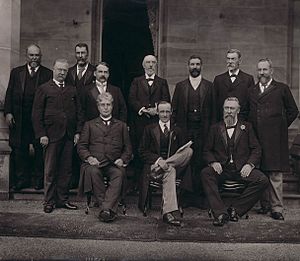
Barton put together a strong team for his government. It included leaders from different colonies. His main goal was to win the first federal election in March 1901. His biggest opponent was George Reid.
Barton made "White Australia" a key part of his election campaign. This policy aimed to limit immigration from Asia and the Pacific Islands. This idea was popular with many working-class voters at the time. Barton's party, the Protectionist Party, won the most seats. They worked with the new Australian Labor Party (ALP) to form the government. Barton himself was elected without anyone running against him in his area.
Important Laws and Policies
Barton announced his plans for the new government in a speech in January 1901. He wanted to create the federal capital, the High Court, and a national postal system. He also promised to give all adults the right to vote in federal elections, build a railway across Australia, and manage disagreements between workers and employers.
One of the first laws his government passed was the Immigration Restriction Act 1901. This law put the "White Australia policy" into action. Barton believed that the idea of "equality of man" did not mean equality between people from different backgrounds.
A very important reform was giving women the right to vote in federal elections in 1902. This made Australia one of the first countries in the world to do this.
Barton was known as a calm and friendly person. He enjoyed good food and wine. Some people jokingly called him "Toby Tosspot" because of his relaxed approach to life.
Travel and International Relations
In 1902, Barton travelled to England for the coronation of King Edward VII. While there, he also discussed how Australia would help pay for naval protection from the British navy. After England, Barton visited Canada before returning home.
Leaving the Prime Minister Role
On 24 September 1903, Barton decided to step down as Prime Minister. He became one of the first judges of the new High Court of Australia. People had been talking about him leaving politics for a while. He had some health issues and his doctor advised him to take a less demanding job. Also, he had faced money problems in the past, and a job as a judge offered more financial security.
His appointment as a judge was widely accepted because he had helped write the Constitution and was an experienced lawyer. Alfred Deakin took over as Prime Minister after Barton.
High Court Justice
Barton started his new role on the High Court on 7 October 1903. His close friends, Samuel Griffith and Richard Edward O'Connor, also became judges. Griffith was the first Chief Justice of Australia. These three judges had worked together on the Constitution. Because they were so close and heard few cases at first, they often agreed on decisions.
The High Court sometimes had disagreements with the government. For example, in 1904, the Attorney-General, Josiah Symon, thought the judges travelled too much. This caused tension, and Barton even thought about resigning. The problem was fixed when Alfred Deakin became Prime Minister again in 1905.
Working on the Court
In 1906, two more judges, H. B. Higgins and Isaac Isaacs, joined the High Court. These new judges were more progressive. Barton and Griffith often formed a group that stuck to the original ideas of the Constitution. Barton usually agreed with Griffith's decisions.
In 1913, Barton was the acting Chief Justice for nine months while Griffith was away. More new judges joined the court that year. This meant Barton and Griffith were sometimes in the minority on important constitutional issues. They wanted to keep the Constitution as it was first intended, while others wanted it to change over time.
Important Court Cases
In a case called D'Emden v Pedder (1904), the High Court decided that the federal and state governments had some protection from each other's laws. This idea was similar to what they had seen in the United States. However, a British court later overturned this decision. Barton was upset because he believed the High Court should be the final court for Australian cases.
During World War I, Barton agreed with the court's decision in Farey v Burvett (1915). This case gave the federal government broad powers to deal with defence during wartime.
Later Life and Passing
Edmund Barton passed away on 7 January 1920, at the age of 70, from heart failure. He was at the Hydro Majestic Hotel in Medlow Bath, New South Wales. He was buried in Waverley Cemetery in Sydney. He was survived by his wife, Jane, and their six children. One of his sons, Edmund Alfred, also became a judge. Another son, Wilfrid Alexander, was the first person from New South Wales to win a Rhodes Scholarship.
Honours and Legacy
Barton was offered knighthoods several times but turned them down. However, in 1902, he accepted the title of Knight Grand Cross of the Order of St Michael and St George (GCMG). King Edward VII personally gave him this honour. He was the only Prime Minister to be knighted while still in office for many years.
He also received special degrees from universities in England and Scotland. In 1905, the Japanese government gave him a special award, the Order of the Rising Sun, for his help in solving a problem between Australia and Japan.
Edmund Barton has been honoured in many ways. His portrait has appeared on Australian postage stamps. The Barton Highway near Canberra is named after him. The Division of Barton in New South Wales, which is an area for elections, is also named in his honour. The suburb of Barton, Australian Capital Territory in Canberra, where many government offices are, is named after him too. The Edmund Barton Building and the Barton College at Deakin University also carry his name.
Images for kids
-
Bust of Sir Edmund Barton in the Prime Ministers Avenue in the Ballarat Botanical Gardens
See also
 In Spanish: Edmund Barton para niños
In Spanish: Edmund Barton para niños



